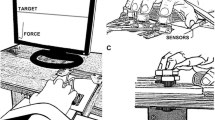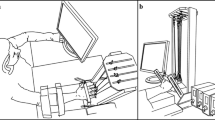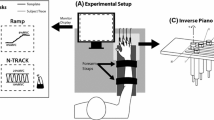Abstract
We studied whether characteristics of individual finger force profiles covaried across repetitions of a quick force pulse production task to stabilize the required magnitude and timing of the peak force. Subjects produced series of quick force pulses by pressing with all four fingers of the right hand on force sensors under the instruction to keep the magnitude of the peak of total force at 15 N and reach the force peaks at prescribed times. Individual finger force pulses were then reshuffled across trials to create a surrogate data set. The surrogate data set showed a lower average peak force with a larger dispersion. This finding has been interpreted as pointing at predominantly negative covariation among finger force pulses in the actual data that stabilized the required magnitude of the total force, a force synergy. The difference between the actual and surrogate data sets was significant early into the pulse time, starting about 40 ms after the pulse initiation. This finding points at a central nature of the negative covariation without a major role played by visual or proprioceptive feedback. In contrast, the surrogate data set showed smaller dispersion of the timing of the total peak force, suggesting positive covariation of the timings of individual finger force pulses in the actual data interpreted as the lack of a timing synergy. These results have been confirmed with principal component (PC) analysis. The first PC for the timing of the individual finger peak forces accounted for over 90% of the total variance for the actual data set and for under 40% of the total variance for the surrogate data set. The fourth PC for the magnitudes of the finger forces accounted for under 4% of the total variance for the actual data set and for over 15% of the variance for the surrogate data set. The data are interpreted within the uncontrolled manifold hypothesis; they support the hierarchical control scheme suggested by Schöner.





Similar content being viewed by others
References
Bernstein NA (1967) The co-ordination and regulation of movements. Pergamon Press, Oxford
Danion F, Schöner G, Latash ML, Li S, Scholz JP, Zatsiorsky VM (2003) A force mode hypothesis for finger interaction during multi-finger force production tasks. Biol Cybern 88:91–98
Keele S, Pokorny R, Corcos D, Ivry R (1985) Do perception and motor production share a common timing mechanism: a correlational analysis. Acta Psychol 60:173–191
Kudo K, Tsutsui S, Ishikura T, Tomoki I, Yamamoto Y (2000) Compensatory coordination of release parameters in a throwing task. J Mot Behav 32:337–345
Latash ML, Scholz JF, Danion F, Schöner G (2001) Structure of motor variability in marginally redundant multi-finger force production tasks. Exp Brain Res 141:153–165
Latash ML, Kang N, Patterson D (2002a) Finger coordination in persons with Down syndrome: atypical patterns of coordination and the effects of practice. Exp Brain Res 146:345–355
Latash ML, Scholz JF, Danion F, Schöner G (2002b) Finger coordination during discrete and oscillatory force production tasks. Exp Brain Res 146:412–432
Li Z-M, Latash ML, Zatsiorsky VM (1998) Force sharing among fingers as a model of the redundancy problem. Exp Brain Res 119:276–286
Muller H, Sternad DS (2003) A randomized method for the calculation of covariation in multiple nonlinear relations illustrated with the example of goal-directed movement. Biol Cybern 89:22–33
Roberts S, Eykholt R, Thaut MH (2000) Analysis of correlations and search for evidence of deterministic chaos in rhythmic motor control by the human brain. Phys Rev E 62:2597–2607
Scholz JP, Danion F, Latash ML, Schöner G (2002) Understanding finger coordination through analysis of the structure of force variability. Biol Cybern 86:29–39
Scholz JP, Kang N, Patterson D, Latash ML (2003) Uncontrolled manifold analysis of single trials during multi-finger force production by persons with and without Down syndrome. Exp Brain Res 153:45–58
Schöner G (1995) Recent developments and problems in human movement science and their conceptual implications. Ecol Psychol 8:291–314
Semjen A, Garcia-Colera A, Requin J (1984) On controlling force and time in rhythmic movement sequences: the effect of stress location. Ann N Y Acad Sci 423:168–182
Shim JK, Latash ML, Zatsiorsky VM (2003) The central nervous system needs time to organize task-specific covariation of finger forces. Neurosci Lett 353:72–74
Shinohara M, Latash ML, Zatsiorsky VM (2003) Age effects on force production by the intrinsic and extrinsic hand muscles and finger interaction during maximal contraction tasks. J Applied Physiol 95:1361–1369
Sternad D, Dean WJ, Newell KM (2000) Force and timing variability in rhythmic unimanual tapping. J Mot Behav 32:249–267
Terzuolo CA, Viviani P (1979) The central representation of learned motor patterns. In: Talbott RE, Humphrey DR (eds) Posture and movement. Raven Press, New York, pp 113–121
Todorov E, Jordan MI (2002) Optimal feedback control as a theory of motor coordination. Nat Neurosci 5:1226–1235
Turvey MT (1990a) Coordination. Amer Psychol 45:938–953
Turvey MT (1990b) The challenge of a physical account of action: a personal view. In: Whiting HTA, Meijer OG, van Wieringen PCW (eds) The natural-physical approach to movement control. VU Univ Press, Amsterdam, pp 57–92
Turvey MT, Schmidt RC, Rosenblum LD (1989) “Clock” and “motor” components in absolute coordination of rhythmic movements. Neurosci 33:1–10
Wing AM, Kristofferson AB (1973) Response delays and the timing of discrete motor responses. Percept Psychophys 14:5–12
Zatsiorsky VM, Li Z-M, Latash ML (1998) Coordinated force production in multi-finger tasks. Finger interaction, enslaving effects, and neural network modeling. Biol Cybern 79:139–150
Zatsiorsky VM, Li Z-M, Latash ML (2000) Enslaving effects in multi-finger force production. Exp Brain Res 131:187–195
Acknowledgements
This study was supported in part by NIH grants AG-018751, NS-35032, and AR-048563.
Author information
Authors and Affiliations
Corresponding author
Rights and permissions
About this article
Cite this article
Latash, M.L., Shim, J.K. & Zatsiorsky, V.M. Is there a timing synergy during multi-finger production of quick force pulses?. Exp Brain Res 159, 65–71 (2004). https://doi.org/10.1007/s00221-004-1933-y
Received:
Accepted:
Published:
Issue Date:
DOI: https://doi.org/10.1007/s00221-004-1933-y




